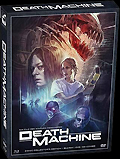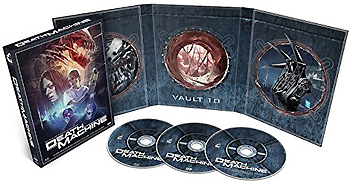BR: Death Machine (1994)
Film: Very Good
Very Good
Transfer: Excellent
Extras: n/a
Label: Turbine Medien
Region: Region B
Released: 2015
Genre: Science-Fiction / Horror
Synopsis: After being promoted as CEO of a highly profitable arms corporation, Hayden Cale finds her rejection of a resident development whiz lethal when he unleashes his personal death machine – all teeth, no love.
Special Features: Director’s Cut on Blu-ray + DVD / Soundtrack CD / Limited Digibook Edition.
Review:
After working his way up / toiling on other people’s projects, visual effects whiz Stephen Norrington made the leap from art department to writer-director with Death Machine, a calling card & instant cult film with a very odd release history, and various running times.
Norrington’s first credits in makeup effects include The Witches (1990), Waxwork II: Lost in Time (1992), and Hellraiser: Bloodline (1996), plus animatronics work for Young Sherlock Holmes (1985), James Cameron’s Aliens (1986), and Richard Stanley’s cult cyberpunk horror Hardware (1990).
Like Norrington’s subsequent The Last Minute (2001), his acidic poke at the worth and effects of fame, Death Machine has its share of veiled barbs at corporate culture, its control over the lives of mid- and low-level employees, and the quick application of obfuscation and denial to save itself when confronted by investigative reports or governmental inquiries that can minimize its overreach of power. (Well, somewhat, as companies too large and established are literally too big to fail and require some propping up when a whole industry and its massive work force face collapse.)
Norrington’s tale is also a mash-up of Alien (1979), Aliens (1986), Robocop (1987), and Saturn 3 (1980), so it’s easy to dismiss the scenario of recently promoted executive Hayden Cale (Ely Pouget) discovering her colleagues remain super-silent when she discovers lead engineer Jack Dante (Brad Dourif) is given an unlimited expense, research, and broad behavioural leeway because he has the power to ruin careers and destroy lives.
Buried in the basement’s Vault 10 is his ‘monster,’ the eponymous death machine that’s more lethal than the company’s faltering human cyborg program. The all-mechanical robot offers potential clients a soulless thing fueled by the pheromones of its doomed, terror-stricken victims. It stalkes, pokes, tears, mulches, and mutilates things human, and leaves in its mangled wake costly redecorating for whole departments.
Both respective auteurs of Hardware and Death Machine share a similar offbeat sense of humour, with sexist slimeball characters and vicious robotic creatures, but whereas Stanley’s monster stemmed from a welded art piece that hungers for its shapely Dr. Frankenstein, Norrington’s is the extension of a spoiled, pubescent brat whose lab is pasted with raunchy centerfolds. Dante also dreams of ‘interfacing’ with Hayden, especially after he discovers her past contains both a tragedy, and in her younger years, some naughty photographic work.
Inspired by the corporate visuals in architecture and interior design of Ridley Scott’s Alien (1979), the head office of the weirdly titled Chaank Armaments is another lone angular slab of steel and glass, but Norrington’s inspiration and homages go a little bit farther. When Dante doesn’t get his way and fears his tenure is seriously threatened, he sends his monster to devour asshole exec Scott Ridley (get it?), played by Richard Brake. When his replacement John Carpenter (get it?), played by William Hootkins, realizes he’s next, he summons Haden from home, and the two are soon pursued by the monster when Dante’s ‘interfacing’ request / demand is flatly rejected.
About a third into the narrative, Norrington switches to a very overt Die Hard (1988) riff, in which three supposed cyber-terrorists in a large truck sneak around the building, and start drilling into the foundations to access the mainframe where they plan to blow up the network, and like Hans and his terrorists for hire, aim to steal a fortune in bonds. Leader (ahem) Sam Raimi (John Sharian) takes his crew of (ahem) Yutani (Martin McDougall) and (ahem) Weyland (Andreas Wisniewski, Die Hard’s Ho-Ho-Ho doomed terrorist Tony), and soon encounter trapped Hayden and Carpenter, and the group eventually make their way towards the basement, losing a couple of members before Dante, Hayden, and the monster have their special person-to-person moment.
Norrington’s riffs from the aforementioned big budget blockbusters are grounded by Dante’s ongoing efforts to ultimately ‘meet’ Hayden on an emotional level, but once the monster is loose, the film switches to Aliens mode, albeit with Raimi donning a Robocopian cybersuit, and having his memory temporarily wiped to become the weapon that’ll offer serious defence against the mangling thing.
Norrington’s smart-assed humour and quips are akin to a teen comedy, and the dialogue isn’t the film’s strongest asset nor are certain cast members who devour the scenery, but somehow, within its 2 hour running time, Pouget keeps the story grounded, and Dourif elevates what more severe critics could brand as a fanboy genre homage / garburation. Moreover, no one can deny that once the machine is unleashed on the final five by Dante, Death Machine lives up to its reputation as a mean, unrelenting action classic that goes far beyond its modest budget.
With models and a mass of practical effects, the impending mayhem is telescoped when Ridley becomes Dante’s first vengeance kill. Norrington’s monster is nasty; it’s as unrelenting and physically similar in minimalist structure as the mass of tubes and metal exoskeleton of Saturn 3’s Hector, but way more primal. The Death Machine is a bottom-feeder that it pins down its prey, and not unlike H.R. Giger’s Alien creature, taunts them with its head comprised of 90% red-painted teeth that clamp & chomp at 300 mph, and spins 360 degrees like a hellish wind-up toy before total mutilation.
Dourif devours the scenery in what might be his most extreme performance on film. He’s a ratty-haired, heavily armed prick who taunts posturing executives from a place of outrageous job security within the corporation, and in one scene he out-spits Brake in a yelling match where both seem to be channelling ‘suffering succotashing’ Sylvester the cat. (Dourif’s character and performance also foreshadows the mad doctor who clones various Ripleys in 1997’s Alien Resurrection, and in the end becomes quite contentedly food for the ‘beautiful’ mutant baby he helped bring into the world.)
John de Borman’s cinematography is gorgeous, and editor Paul Endacott brings extra tightness to the kill montages, with the monster’s POV readout evoking a video game. Crispin Merrell’s largely synth score follows a similar industrial sound palette used by Brad Fiedel in The Terminator (1984), but it loses some potent oomph due to the sound mix which dials down the music in favour of sound effects. Some dialogue by Dourif is very soft, and when Norrington cuts to the monster’s POV, the 5.1 sound spectrum snaps into a very wide field, albeit lacking needed bass, although pounding low frequencies are largely saved for the outrageously long salvo that Hayden and Yutani unleash on their tormentor.
Director Norrington has a small role as an exec an early boardroom scene, as does an almost unrecognizable Rachel Weisz (black hair, nose ring). Although the homages, riffs, and grafts from other films are heavily interlaced, the film’s strength is clearly Norrington’s creature design, and the last 40-odd minutes which, at their peak, are incredible.
The running time of Death Machine has added to the film’s cult following. A Japanese laserdisc reportedly sported a 121 min. Director’s Cut, which was later released on a German Region 2 DVD, but with a German-only dub track. A Spanish-dubbed Region 2 DVD (and reportedly Blu-ray) features a longer 128 min. cut which Norrington doesn’t like, and the U.S. DVD sported a fullscreen 99 min. cut that trimmed material for pacing.

Although the Japanese laserdisc contains a roughly 7 min. making-of featurette and trailer, the recent German Blu-ray (limited to 3000 copies) sports the Director’s Cut with English 5.1 audio on Blu + DVD, and a soundtrack CD. This lavish release with gorgeous cover art really, really should’ve been more widely released, if not licensed to a North American label, being the definitive presentation of this cult film. Death Machine proved to be a successful a calling card, enabling Norrington to direct his best-known (and most satisfying) gig, Blade (1998), a near-perfect entry in the hip modern vampire sub-genre due to its cast, direction, sleek production, and superb blend of pulsing score and pounding source music.
Blade should’ve yielded a mass of work, but his next film, The Last Minute, feels like Norrington’s hybridized techno-musical rumination on not just the worth of fame and its corrosive backsplash, but perhaps his own place within the corporate studio system. After the disastrous The League of Gentlemen (2003), Norrington vanished from directing, with rare effects credits popping up in Renny Harlin’s dreadful Exorcist: The Beginning (2004) and Harbinger Down (2015).
It’s a shame, because Blade represents his firm grasp of sound and image for the big screen; more great material should’ve followed since the peak of that withering vampire franchise debuted more than 20 years ago.
Will there be a comeback?
© 2020 Mark R. Hasan
External References:
Editor’s Blog — IMDB — Composer Filmography
Vendor Search Links:
Amazon Canada
— Amazon USA
— Amazon UK
Category: Blu-ray / DVD Film Review

















Connect